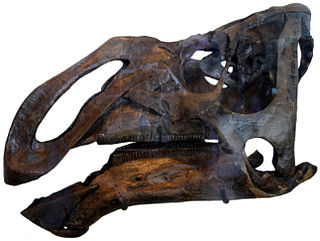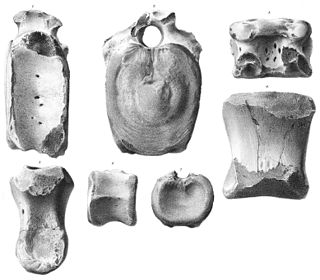
Trachodon is a dubious genus of hadrosaurid dinosaur based on teeth from the Campanian-age Upper Cretaceous Judith River Formation of Montana, U.S. It is a historically important genus with a convoluted taxonomy that has been all but abandoned by modern dinosaur paleontologists.

Chasmosaurus is a genus of ceratopsid dinosaur from the Late Cretaceous Period in North America. Its given name means 'opening lizard', referring to the large openings (fenestrae) in its frill. With a length of 4.3–4.8 metres (14.1–15.7 ft) and a weight of 1.5–2 tonnes —or anywhere from 2,200 to nearly 5,000 lbs., give or take—Chasmosaurus was of a slightly smaller to ‘average’ size, especially when compared to larger ceratopsians. The Chasmosaurs were similar, in overall build and weight, to a white rhinoceros or an Indian rhinoceros; just like rhinos, and all other ceratopsians, they were purely herbivorous, needing to consume around 54 kilograms, or 120 lbs., of plant matter each day.

Gorgosaurus is a genus of tyrannosaurid theropod dinosaur that lived in western North America during the Late Cretaceous Period (Campanian), between about 76.6 and 75.1 million years ago. Fossil remains have been found in the Canadian province of Alberta and the U.S. state of Montana. Paleontologists recognize only the type species, G. libratus, although other species have been erroneously referred to the genus.

Corythosaurus is a genus of hadrosaurid "duck-billed" dinosaur from the Late Cretaceous period, about 77–75.7 million years ago, in what is now western North America. Its name is derived from the Greek word κόρυς, meaning "helmet", named and described in 1914 by Barnum Brown. Corythosaurus is now thought to be a lambeosaurine, thus related to Lambeosaurus, Nipponosaurus, Velafrons, Hypacrosaurus, and Olorotitan. Corythosaurus has an estimated length of 7.7–9 metres (25–30 ft) and has a skull, including the crest, that is 70.8 centimetres tall.

Edmontosaurus, often colloquially and historically known as Anatosaurus, is a genus of hadrosaurid (duck-billed) dinosaur It contains two known species: Edmontosaurus regalis and Edmontosaurus annectens. Fossils of E. regalis have been found in rocks of western North America that date from the late Campanian age of the Cretaceous period 73 million years ago, while those of E. annectens were found in the same geographic region from rocks dated to the end of the Maastrichtian age, 66 million years ago. Edmontosaurus was one of the last non-avian dinosaurs to ever exist, and lived alongside dinosaurs like Triceratops, Tyrannosaurus, Ankylosaurus, and Pachycephalosaurus shortly before the Cretaceous–Paleogene extinction event.

Lambeosaurus is a genus of hadrosaurid dinosaur that lived about 75 million years ago, in the Late Cretaceous period of North America. This bipedal/quadrupedal, herbivorous dinosaur is known for its distinctive hollow cranial crest, which in the best-known species resembled a mitten. Several possible species have been named, from Canada, the United States, and Mexico, but only the two Canadian species are currently recognized as valid.

Claosaurus is a genus of hadrosauroid dinosaur that lived during the Late Cretaceous Period (Santonian-Campanian).

Hypacrosaurus was a genus of duckbill dinosaur similar in appearance to Corythosaurus. Like Corythosaurus, it had a tall, hollow rounded crest, although not as large and straight. It is known from the remains of two species that spanned 75 to 67 million years ago, in the Late Cretaceous of Alberta, Canada, and Montana, United States, and is the latest hollow-crested duckbill known from good remains in North America. It was an obscure genus until the discovery in the 1990s of nests, eggs, and hatchlings belonging to H. stebingeri.

Gryposaurus was a genus of duckbilled dinosaur that lived about 80 to 75 million years ago, in the Late Cretaceous of North America. Named species of Gryposaurus are known from the Dinosaur Park Formation in Alberta, Canada, and two formations in the United States: the Lower Two Medicine Formation in Montana and the Kaiparowits Formation of Utah. A possible additional species from the Javelina Formation in Texas may extend the temporal range of the genus to 66 million years ago.

Kritosaurus is an incompletely known genus of hadrosaurid (duck-billed) dinosaur. It lived about 74.5-66 million years ago, in the Late Cretaceous of North America. The name means "separated lizard", but is often mistranslated as "noble lizard" in reference to the presumed "Roman nose".

Monoclonius is an extinct genus of herbivorous ceratopsian dinosaur found in the Late Cretaceous layers of the Judith River Formation in Montana, United States, and the uppermost rock layers of the Dinosaur Park Formation in Alberta, Canada dated to between 75 and 74.6 million years ago.

Thespesius is a dubious genus of hadrosaurid dinosaur from the late Maastrichtian-age Upper Cretaceous Lance Formation of South Dakota.

Prosaurolophus is a genus of hadrosaurid dinosaur from the Late Cretaceous of North America. It is known from the remains of at least 25 individuals belonging to two species, including skulls and skeletons, but it remains obscure. Its fossils have been found in the late Campanian-age Upper Cretaceous Dinosaur Park Formation in Alberta, and the roughly contemporaneous Two Medicine Formation in Montana, dating to around 75.5-74.0 million years ago. Its most recognizable feature is a small solid crest formed by the nasal bones, sticking up in front of the eyes.

Lawrence Morris Lambe was a Canadian geologist, palaeontologist, and ecologist from the Geological Survey of Canada (GSC). His published work, describing the diverse and plentiful dinosaur discoveries from the fossil beds in Alberta, did much to bring dinosaurs into the public eye and helped usher in the Golden Age of Dinosaurs in the province. During this period, between the 1880s and World War I, dinosaur hunters from all over the world converged on Alberta. Lambeosaurus, a well-known hadrosaur, was named after him as a tribute, in 1923. In addition to paleontology, Lambe discovered a number of invertebrate species ranging from Canada to the Pacific Northwest. Lambe's contemporary discoveries were published in works such as Sponges From the Atlantic Coast of Canada and Catalogue of the recent marine sponges of Canada and Alaska.

Edmontosaurus regalis is a species of comb-crested hadrosaurid dinosaur. Fossils of E. regalis have been found in rocks of western North America that date from the late Campanian age of the Cretaceous Period 73 million years ago, but it may have possibly lived into the early Maastrichtian.

Edmontosaurus annectens, often colloquially and historically known as the Anatosaurus, is a species of flat-headed saurolophine hadrosaurid dinosaur from the late Maastrichtian age at the very end of the Cretaceous period, in what is now western North America. Remains of E. annectens have been preserved in the Frenchman, Hell Creek, and Lance Formations. All of these formations are dated to the late Maastrichtian age of the Late Cretaceous period, which represents the last three million years before the extinction of the dinosaurs. E. annectens is also found in the Laramie Formation and magnetostratigraphy suggests an age of 69-68 Ma for the Laramie Formation. Edmontosaurus annectens is known from numerous specimens, including at least twenty partial to complete skulls, discovered in the U.S. states of Montana, South Dakota, North Dakota, Wyoming, and Colorado, as well as the Canadian province of Saskatchewan. It had an extremely long and low skull and was quite a large animal, growing up to approximately 12 metres (39 ft) in length and 5.6 metric tons in average asymptotic body mass, although it could have been even larger. E. annectens exhibits one of the most striking examples of the "duckbill" snout that is common to hadrosaurs. It has a long taxonomic history and specimens have at times been classified as Diclonius, Trachodon, Hadrosaurus, Claosaurus, Thespesius, Anatosaurus, and Anatotitan before all being grouped together in Edmontosaurus

Foraminacephale is a genus of pachycephalosaurid dinosaur from Late Cretaceous deposits of Canada.

Kritosaurini is a tribe of saurolophine hadrosaurid dinosaurs from the Late Cretaceous.

This timeline of hadrosaur research is a chronological listing of events in the history of paleontology focused on the hadrosauroids, a group of herbivorous ornithopod dinosaurs popularly known as the duck-billed dinosaurs. Scientific research on hadrosaurs began in the 1850s, when Joseph Leidy described the genera Thespesius and Trachodon based on scrappy fossils discovered in the western United States. Just two years later he published a description of the much better-preserved remains of an animal from New Jersey that he named Hadrosaurus.

Probrachylophosaurus bergei is a species of large herbivorous brachylophosaurin hadrosaurid dinosaur known from the Late Cretaceous Campanian Judith River Formation, of Montana and the Foremost Formation of Alberta.





















